Fair Value Accounting: A Comprehensive Analysis of Limitations
VerifiedAdded on 2019/11/12
|8
|1377
|176
Report
AI Summary
This report provides a comprehensive overview of fair value accounting, focusing on its core concepts, the relevant accounting standard IFRS 13, and the inherent limitations of this valuation method. The report defines fair value as the price an entity would receive for an asset in the market and explores the fair value hierarchy. It then discusses how fair value is determined and the assumptions involved, as well as the characteristics of assets and liabilities that must be considered. The report also examines the limitations of fair value accounting, such as the challenges in comparing assets with historical costs and the volatility it can introduce, potentially leading to short-term gains and losses. The report concludes by summarizing the concept, its usefulness, and its drawbacks, emphasizing the importance of understanding these limitations for investors and financial statement users. This report is designed to assist students with their understanding of fair value accounting.
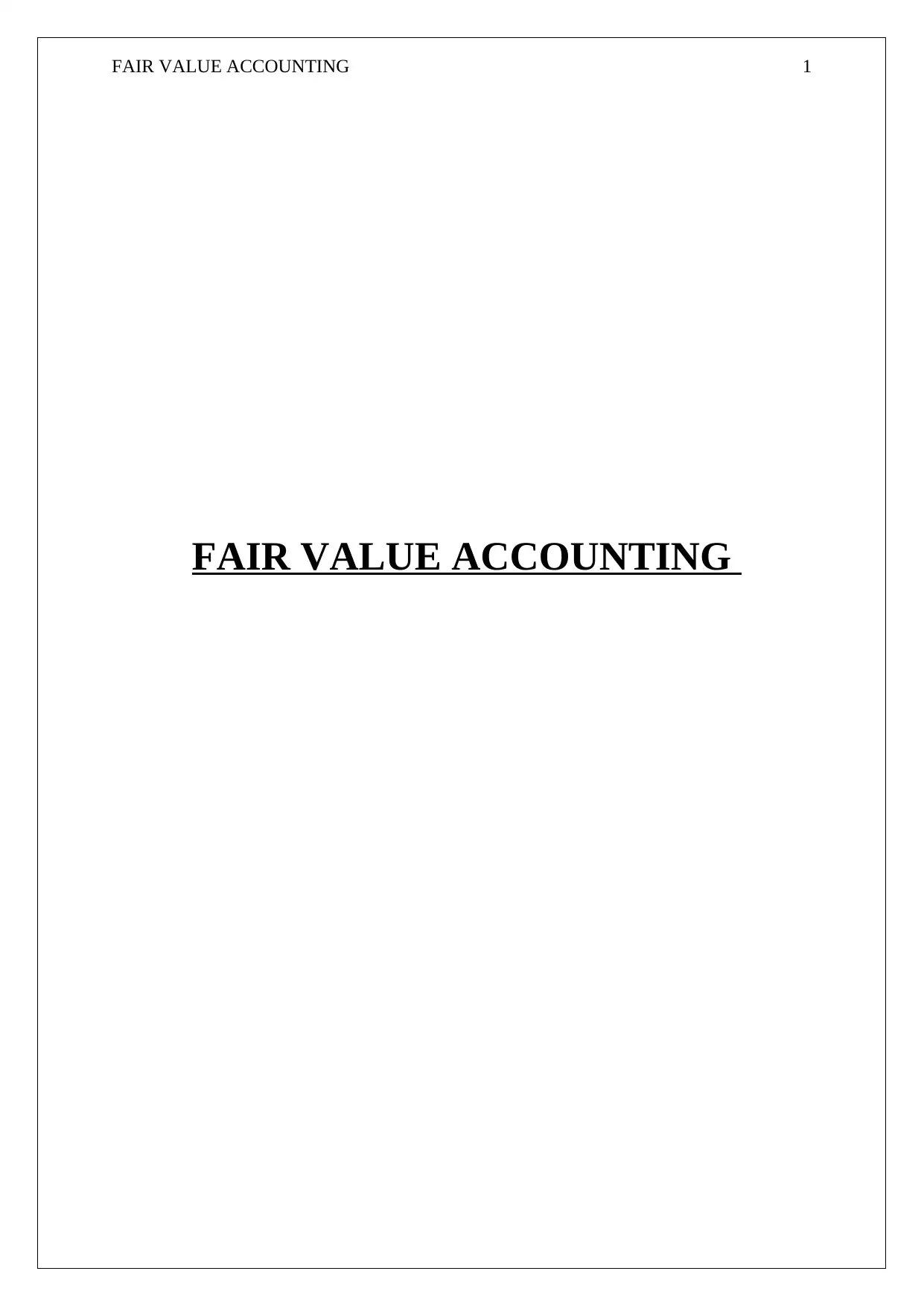
FAIR VALUE ACCOUNTING 1
FAIR VALUE ACCOUNTING
FAIR VALUE ACCOUNTING
Paraphrase This Document
Need a fresh take? Get an instant paraphrase of this document with our AI Paraphraser
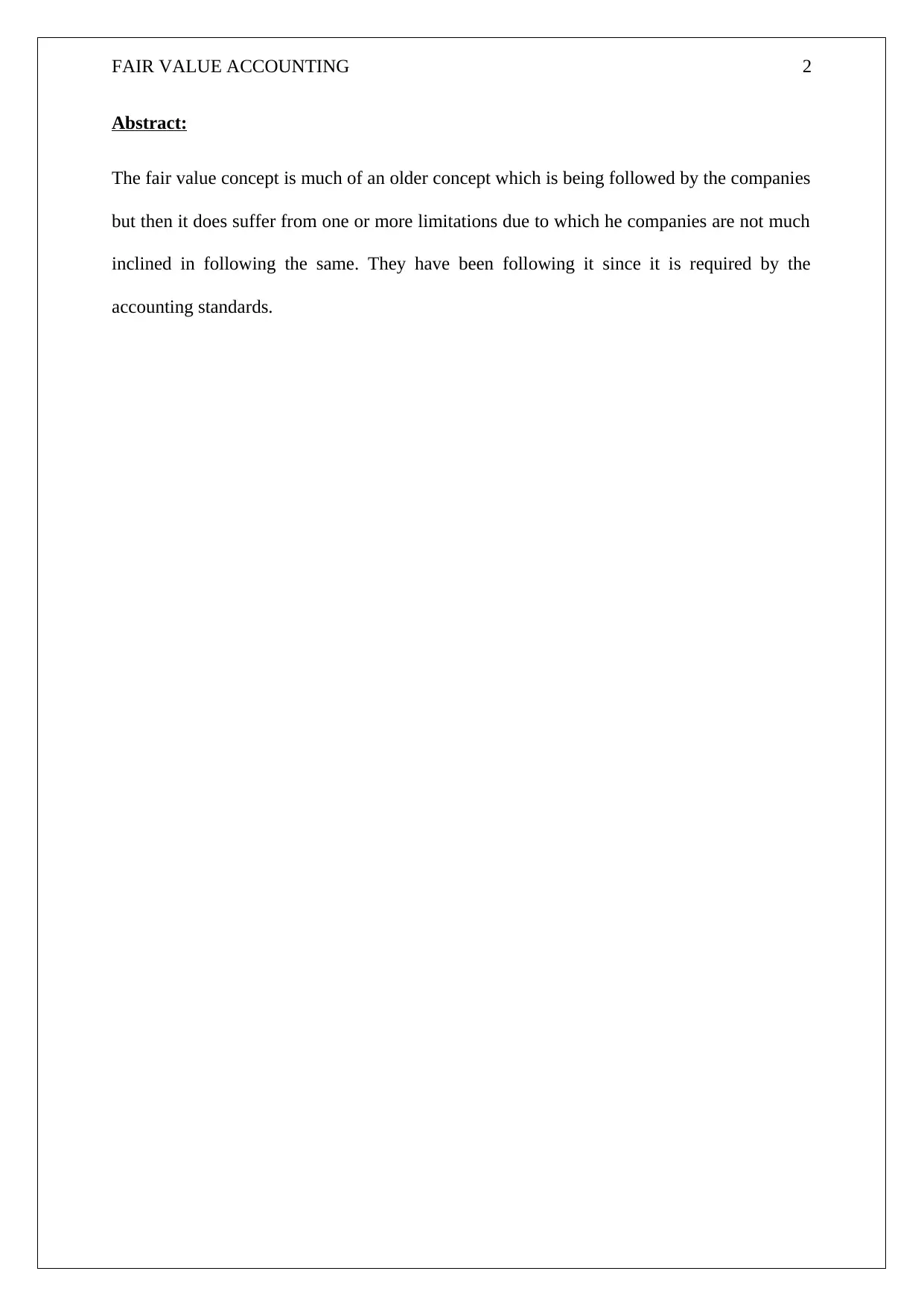
FAIR VALUE ACCOUNTING 2
Abstract:
The fair value concept is much of an older concept which is being followed by the companies
but then it does suffer from one or more limitations due to which he companies are not much
inclined in following the same. They have been following it since it is required by the
accounting standards.
Abstract:
The fair value concept is much of an older concept which is being followed by the companies
but then it does suffer from one or more limitations due to which he companies are not much
inclined in following the same. They have been following it since it is required by the
accounting standards.
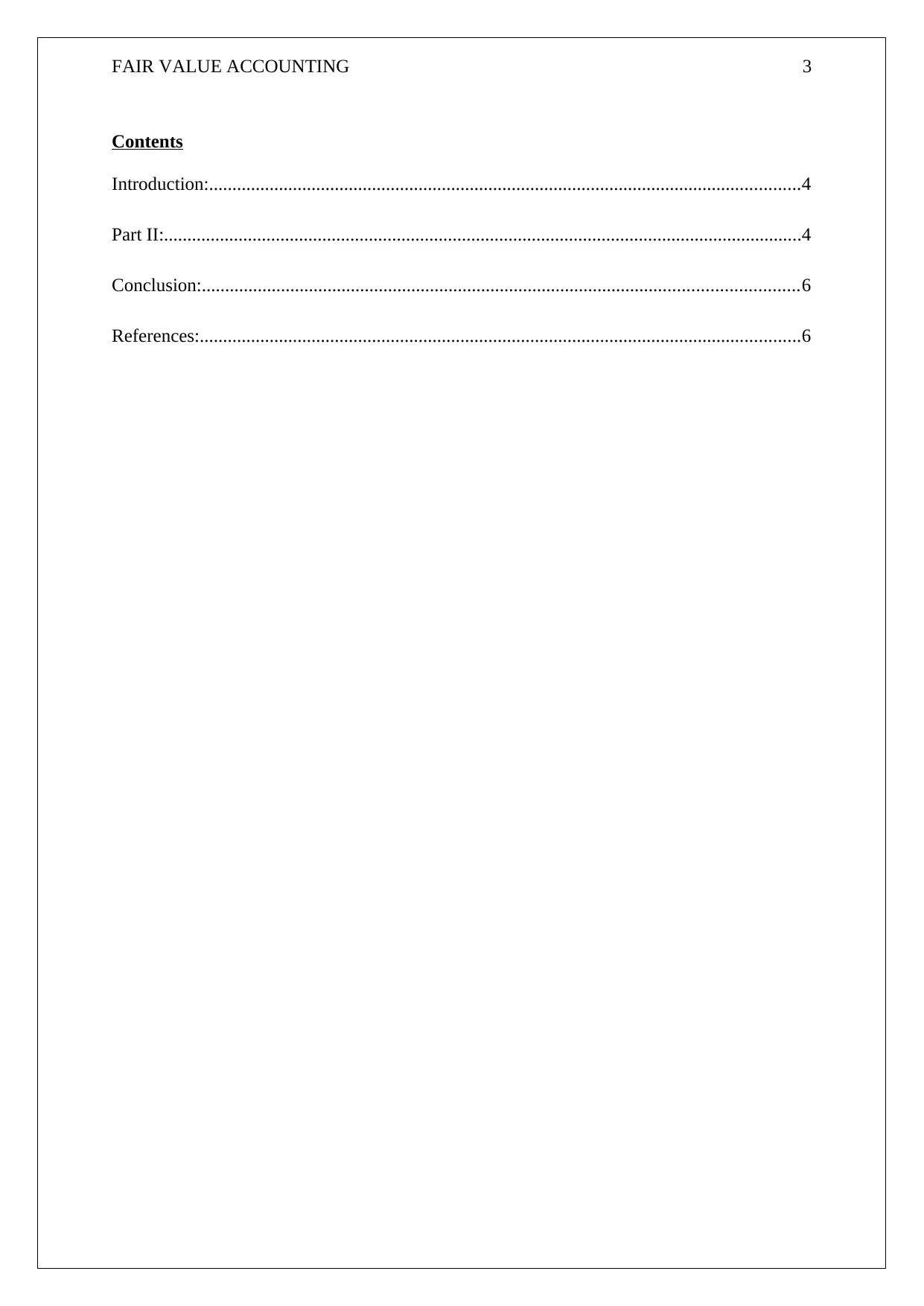
FAIR VALUE ACCOUNTING 3
Contents
Introduction:...............................................................................................................................4
Part II:.........................................................................................................................................4
Conclusion:................................................................................................................................6
References:.................................................................................................................................6
Contents
Introduction:...............................................................................................................................4
Part II:.........................................................................................................................................4
Conclusion:................................................................................................................................6
References:.................................................................................................................................6
⊘ This is a preview!⊘
Do you want full access?
Subscribe today to unlock all pages.

Trusted by 1+ million students worldwide
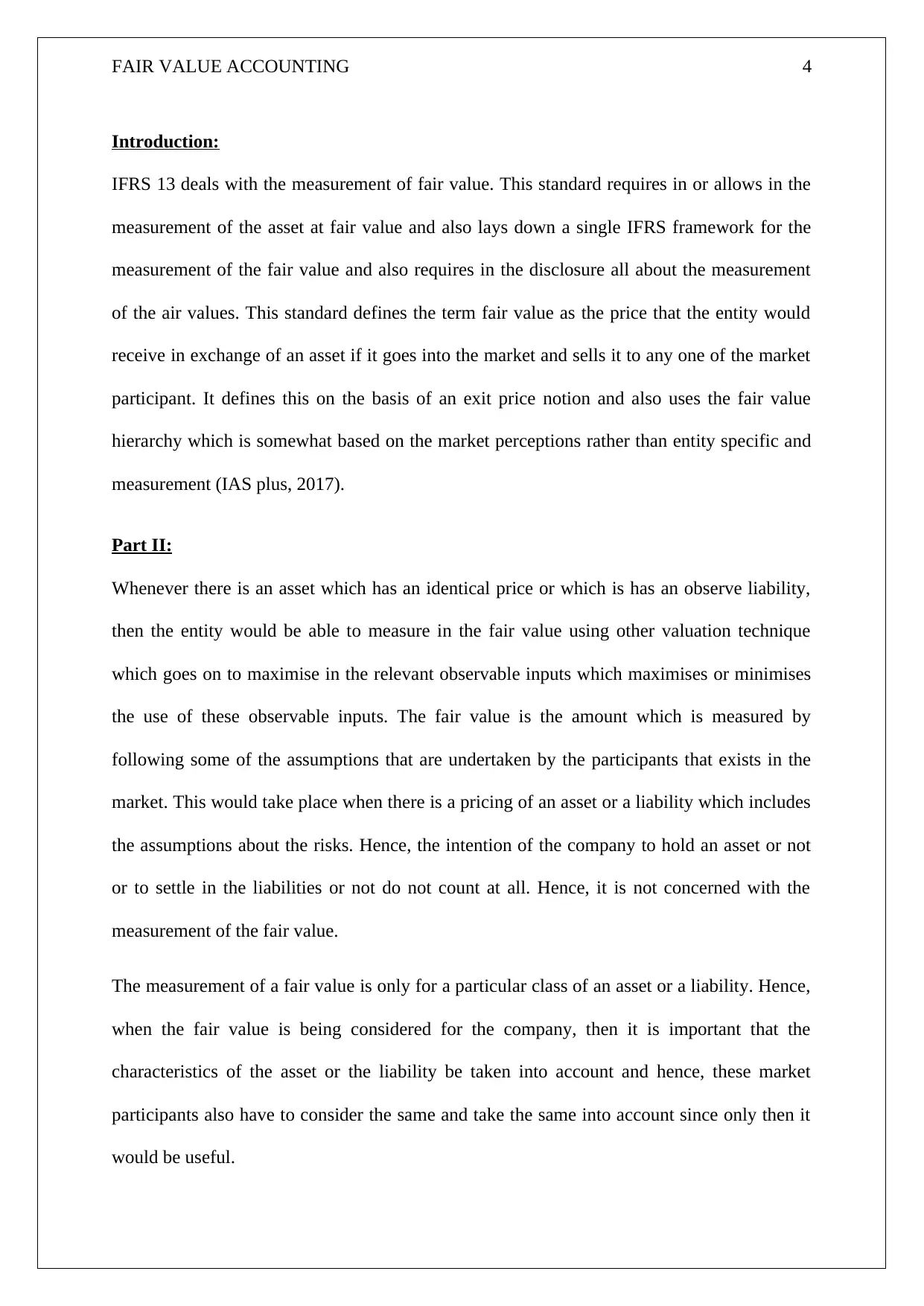
FAIR VALUE ACCOUNTING 4
Introduction:
IFRS 13 deals with the measurement of fair value. This standard requires in or allows in the
measurement of the asset at fair value and also lays down a single IFRS framework for the
measurement of the fair value and also requires in the disclosure all about the measurement
of the air values. This standard defines the term fair value as the price that the entity would
receive in exchange of an asset if it goes into the market and sells it to any one of the market
participant. It defines this on the basis of an exit price notion and also uses the fair value
hierarchy which is somewhat based on the market perceptions rather than entity specific and
measurement (IAS plus, 2017).
Part II:
Whenever there is an asset which has an identical price or which is has an observe liability,
then the entity would be able to measure in the fair value using other valuation technique
which goes on to maximise in the relevant observable inputs which maximises or minimises
the use of these observable inputs. The fair value is the amount which is measured by
following some of the assumptions that are undertaken by the participants that exists in the
market. This would take place when there is a pricing of an asset or a liability which includes
the assumptions about the risks. Hence, the intention of the company to hold an asset or not
or to settle in the liabilities or not do not count at all. Hence, it is not concerned with the
measurement of the fair value.
The measurement of a fair value is only for a particular class of an asset or a liability. Hence,
when the fair value is being considered for the company, then it is important that the
characteristics of the asset or the liability be taken into account and hence, these market
participants also have to consider the same and take the same into account since only then it
would be useful.
Introduction:
IFRS 13 deals with the measurement of fair value. This standard requires in or allows in the
measurement of the asset at fair value and also lays down a single IFRS framework for the
measurement of the fair value and also requires in the disclosure all about the measurement
of the air values. This standard defines the term fair value as the price that the entity would
receive in exchange of an asset if it goes into the market and sells it to any one of the market
participant. It defines this on the basis of an exit price notion and also uses the fair value
hierarchy which is somewhat based on the market perceptions rather than entity specific and
measurement (IAS plus, 2017).
Part II:
Whenever there is an asset which has an identical price or which is has an observe liability,
then the entity would be able to measure in the fair value using other valuation technique
which goes on to maximise in the relevant observable inputs which maximises or minimises
the use of these observable inputs. The fair value is the amount which is measured by
following some of the assumptions that are undertaken by the participants that exists in the
market. This would take place when there is a pricing of an asset or a liability which includes
the assumptions about the risks. Hence, the intention of the company to hold an asset or not
or to settle in the liabilities or not do not count at all. Hence, it is not concerned with the
measurement of the fair value.
The measurement of a fair value is only for a particular class of an asset or a liability. Hence,
when the fair value is being considered for the company, then it is important that the
characteristics of the asset or the liability be taken into account and hence, these market
participants also have to consider the same and take the same into account since only then it
would be useful.
Paraphrase This Document
Need a fresh take? Get an instant paraphrase of this document with our AI Paraphraser
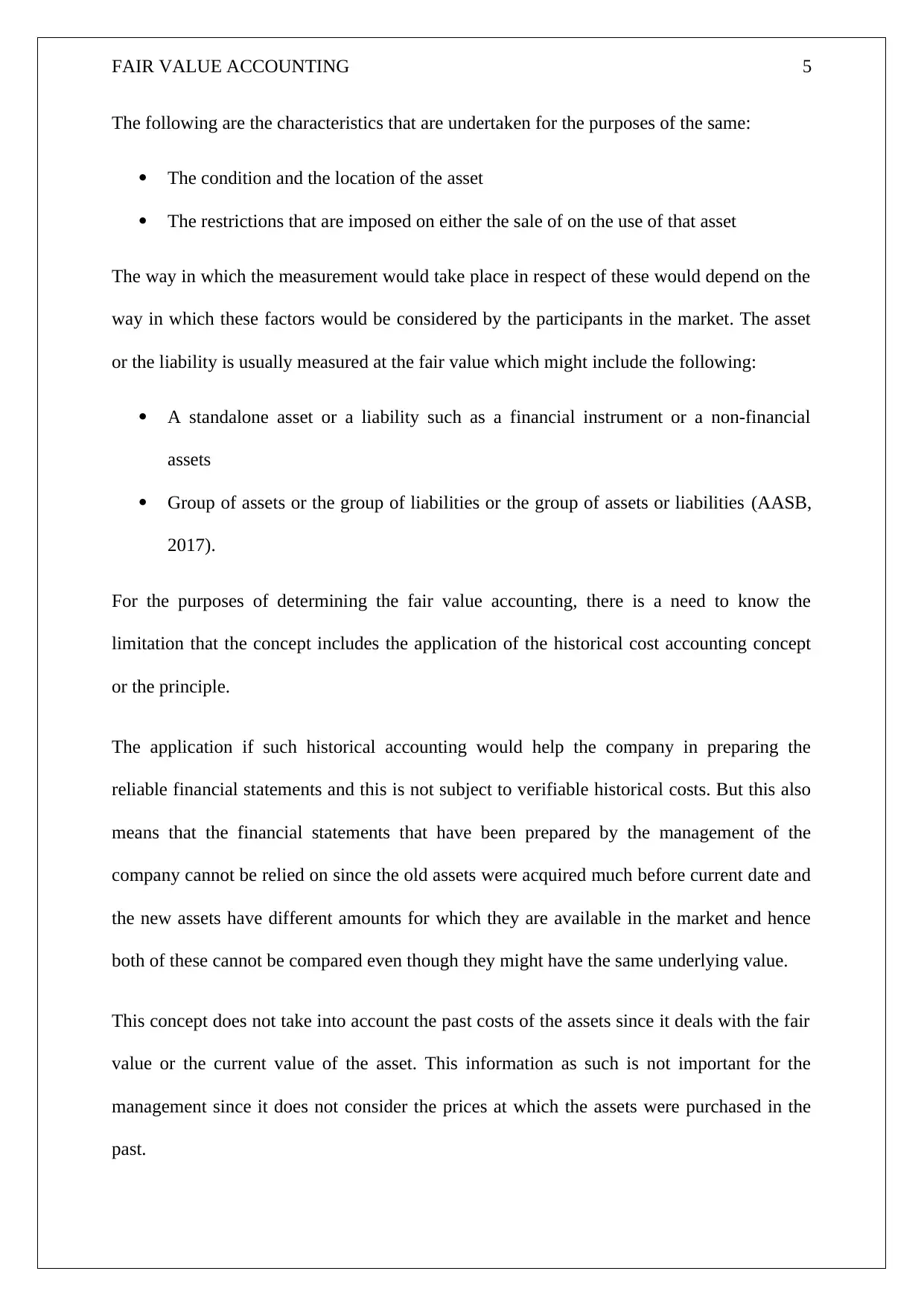
FAIR VALUE ACCOUNTING 5
The following are the characteristics that are undertaken for the purposes of the same:
The condition and the location of the asset
The restrictions that are imposed on either the sale of on the use of that asset
The way in which the measurement would take place in respect of these would depend on the
way in which these factors would be considered by the participants in the market. The asset
or the liability is usually measured at the fair value which might include the following:
A standalone asset or a liability such as a financial instrument or a non-financial
assets
Group of assets or the group of liabilities or the group of assets or liabilities (AASB,
2017).
For the purposes of determining the fair value accounting, there is a need to know the
limitation that the concept includes the application of the historical cost accounting concept
or the principle.
The application if such historical accounting would help the company in preparing the
reliable financial statements and this is not subject to verifiable historical costs. But this also
means that the financial statements that have been prepared by the management of the
company cannot be relied on since the old assets were acquired much before current date and
the new assets have different amounts for which they are available in the market and hence
both of these cannot be compared even though they might have the same underlying value.
This concept does not take into account the past costs of the assets since it deals with the fair
value or the current value of the asset. This information as such is not important for the
management since it does not consider the prices at which the assets were purchased in the
past.
The following are the characteristics that are undertaken for the purposes of the same:
The condition and the location of the asset
The restrictions that are imposed on either the sale of on the use of that asset
The way in which the measurement would take place in respect of these would depend on the
way in which these factors would be considered by the participants in the market. The asset
or the liability is usually measured at the fair value which might include the following:
A standalone asset or a liability such as a financial instrument or a non-financial
assets
Group of assets or the group of liabilities or the group of assets or liabilities (AASB,
2017).
For the purposes of determining the fair value accounting, there is a need to know the
limitation that the concept includes the application of the historical cost accounting concept
or the principle.
The application if such historical accounting would help the company in preparing the
reliable financial statements and this is not subject to verifiable historical costs. But this also
means that the financial statements that have been prepared by the management of the
company cannot be relied on since the old assets were acquired much before current date and
the new assets have different amounts for which they are available in the market and hence
both of these cannot be compared even though they might have the same underlying value.
This concept does not take into account the past costs of the assets since it deals with the fair
value or the current value of the asset. This information as such is not important for the
management since it does not consider the prices at which the assets were purchased in the
past.
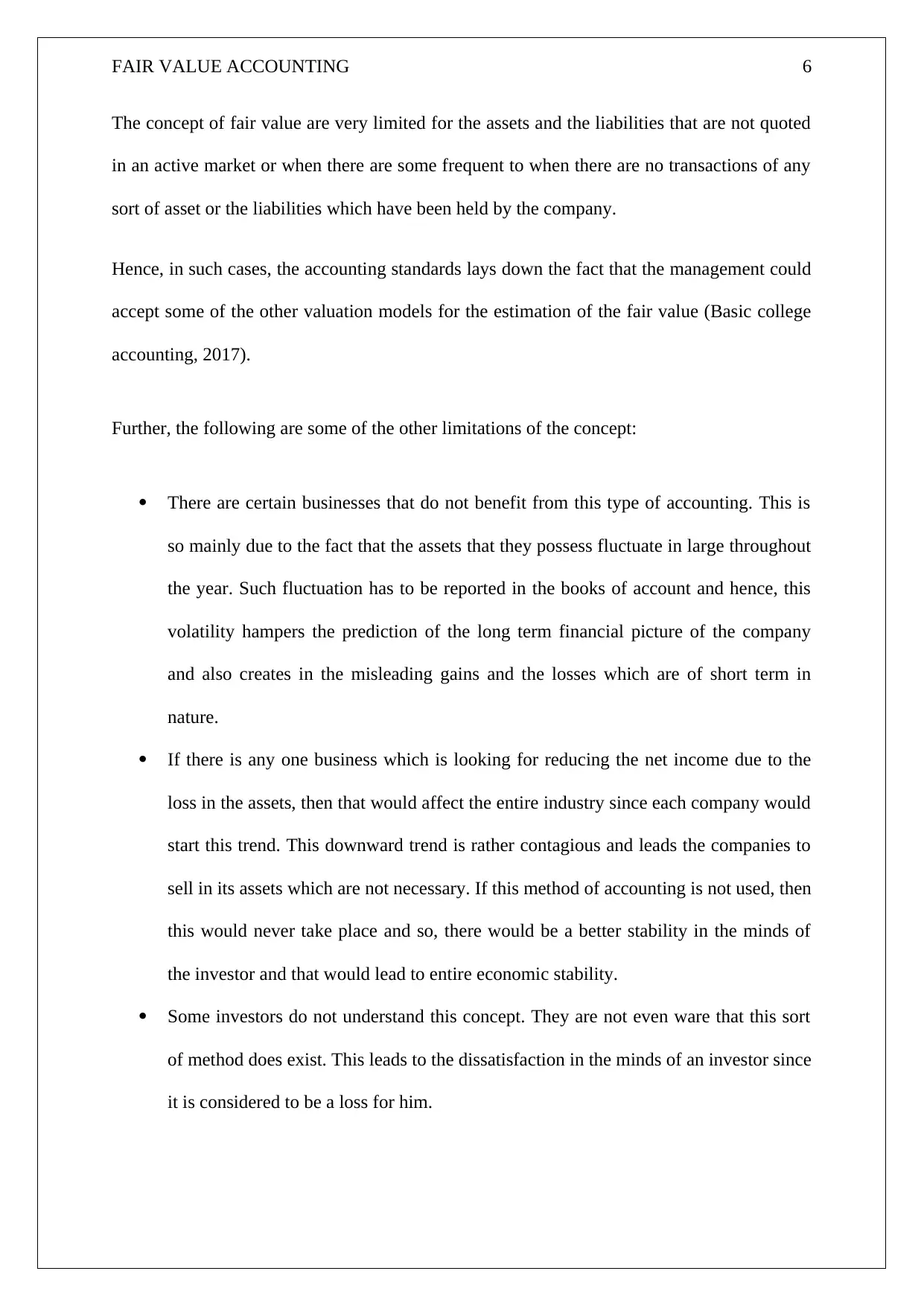
FAIR VALUE ACCOUNTING 6
The concept of fair value are very limited for the assets and the liabilities that are not quoted
in an active market or when there are some frequent to when there are no transactions of any
sort of asset or the liabilities which have been held by the company.
Hence, in such cases, the accounting standards lays down the fact that the management could
accept some of the other valuation models for the estimation of the fair value (Basic college
accounting, 2017).
Further, the following are some of the other limitations of the concept:
There are certain businesses that do not benefit from this type of accounting. This is
so mainly due to the fact that the assets that they possess fluctuate in large throughout
the year. Such fluctuation has to be reported in the books of account and hence, this
volatility hampers the prediction of the long term financial picture of the company
and also creates in the misleading gains and the losses which are of short term in
nature.
If there is any one business which is looking for reducing the net income due to the
loss in the assets, then that would affect the entire industry since each company would
start this trend. This downward trend is rather contagious and leads the companies to
sell in its assets which are not necessary. If this method of accounting is not used, then
this would never take place and so, there would be a better stability in the minds of
the investor and that would lead to entire economic stability.
Some investors do not understand this concept. They are not even ware that this sort
of method does exist. This leads to the dissatisfaction in the minds of an investor since
it is considered to be a loss for him.
The concept of fair value are very limited for the assets and the liabilities that are not quoted
in an active market or when there are some frequent to when there are no transactions of any
sort of asset or the liabilities which have been held by the company.
Hence, in such cases, the accounting standards lays down the fact that the management could
accept some of the other valuation models for the estimation of the fair value (Basic college
accounting, 2017).
Further, the following are some of the other limitations of the concept:
There are certain businesses that do not benefit from this type of accounting. This is
so mainly due to the fact that the assets that they possess fluctuate in large throughout
the year. Such fluctuation has to be reported in the books of account and hence, this
volatility hampers the prediction of the long term financial picture of the company
and also creates in the misleading gains and the losses which are of short term in
nature.
If there is any one business which is looking for reducing the net income due to the
loss in the assets, then that would affect the entire industry since each company would
start this trend. This downward trend is rather contagious and leads the companies to
sell in its assets which are not necessary. If this method of accounting is not used, then
this would never take place and so, there would be a better stability in the minds of
the investor and that would lead to entire economic stability.
Some investors do not understand this concept. They are not even ware that this sort
of method does exist. This leads to the dissatisfaction in the minds of an investor since
it is considered to be a loss for him.
⊘ This is a preview!⊘
Do you want full access?
Subscribe today to unlock all pages.

Trusted by 1+ million students worldwide
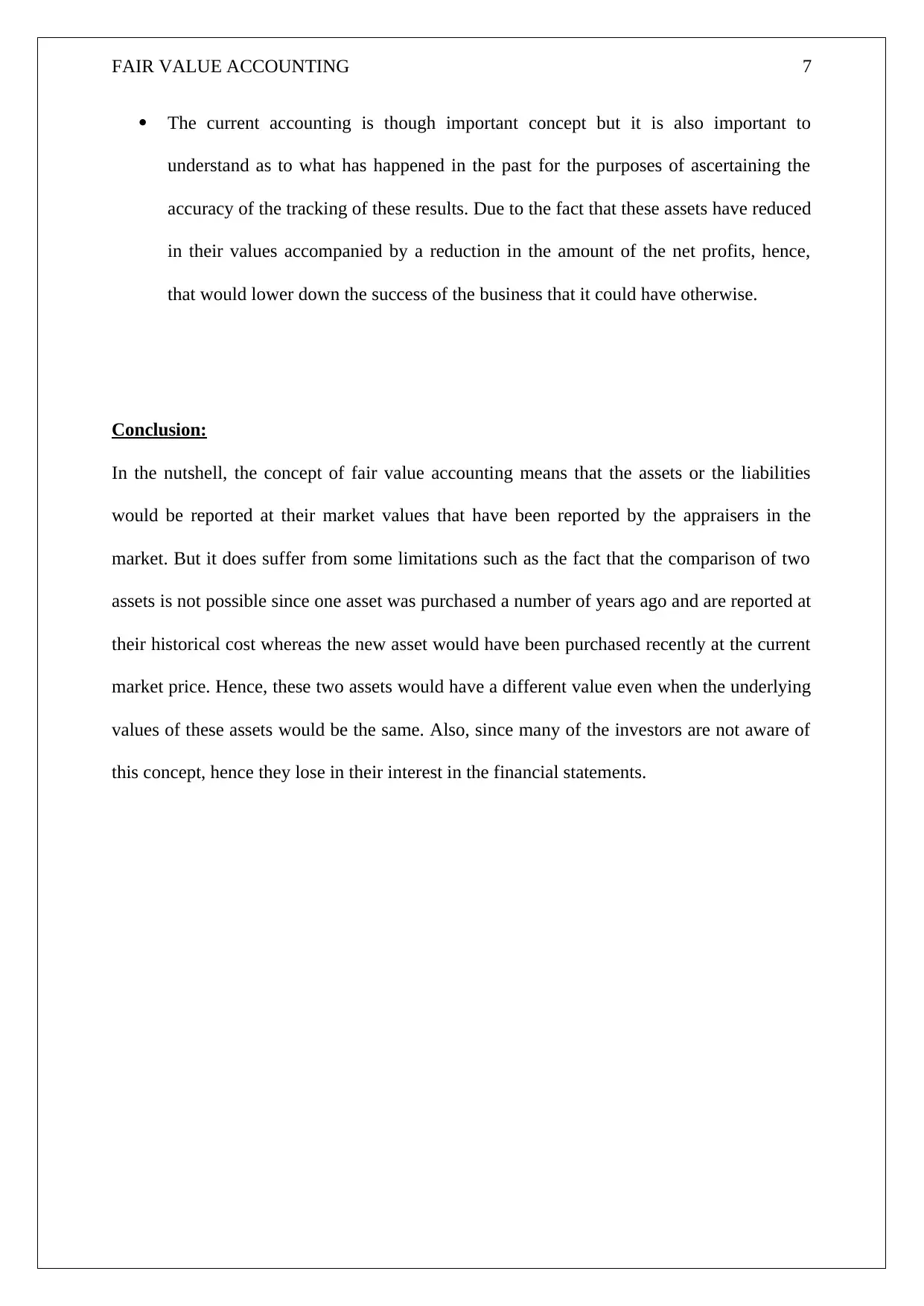
FAIR VALUE ACCOUNTING 7
The current accounting is though important concept but it is also important to
understand as to what has happened in the past for the purposes of ascertaining the
accuracy of the tracking of these results. Due to the fact that these assets have reduced
in their values accompanied by a reduction in the amount of the net profits, hence,
that would lower down the success of the business that it could have otherwise.
Conclusion:
In the nutshell, the concept of fair value accounting means that the assets or the liabilities
would be reported at their market values that have been reported by the appraisers in the
market. But it does suffer from some limitations such as the fact that the comparison of two
assets is not possible since one asset was purchased a number of years ago and are reported at
their historical cost whereas the new asset would have been purchased recently at the current
market price. Hence, these two assets would have a different value even when the underlying
values of these assets would be the same. Also, since many of the investors are not aware of
this concept, hence they lose in their interest in the financial statements.
The current accounting is though important concept but it is also important to
understand as to what has happened in the past for the purposes of ascertaining the
accuracy of the tracking of these results. Due to the fact that these assets have reduced
in their values accompanied by a reduction in the amount of the net profits, hence,
that would lower down the success of the business that it could have otherwise.
Conclusion:
In the nutshell, the concept of fair value accounting means that the assets or the liabilities
would be reported at their market values that have been reported by the appraisers in the
market. But it does suffer from some limitations such as the fact that the comparison of two
assets is not possible since one asset was purchased a number of years ago and are reported at
their historical cost whereas the new asset would have been purchased recently at the current
market price. Hence, these two assets would have a different value even when the underlying
values of these assets would be the same. Also, since many of the investors are not aware of
this concept, hence they lose in their interest in the financial statements.
Paraphrase This Document
Need a fresh take? Get an instant paraphrase of this document with our AI Paraphraser
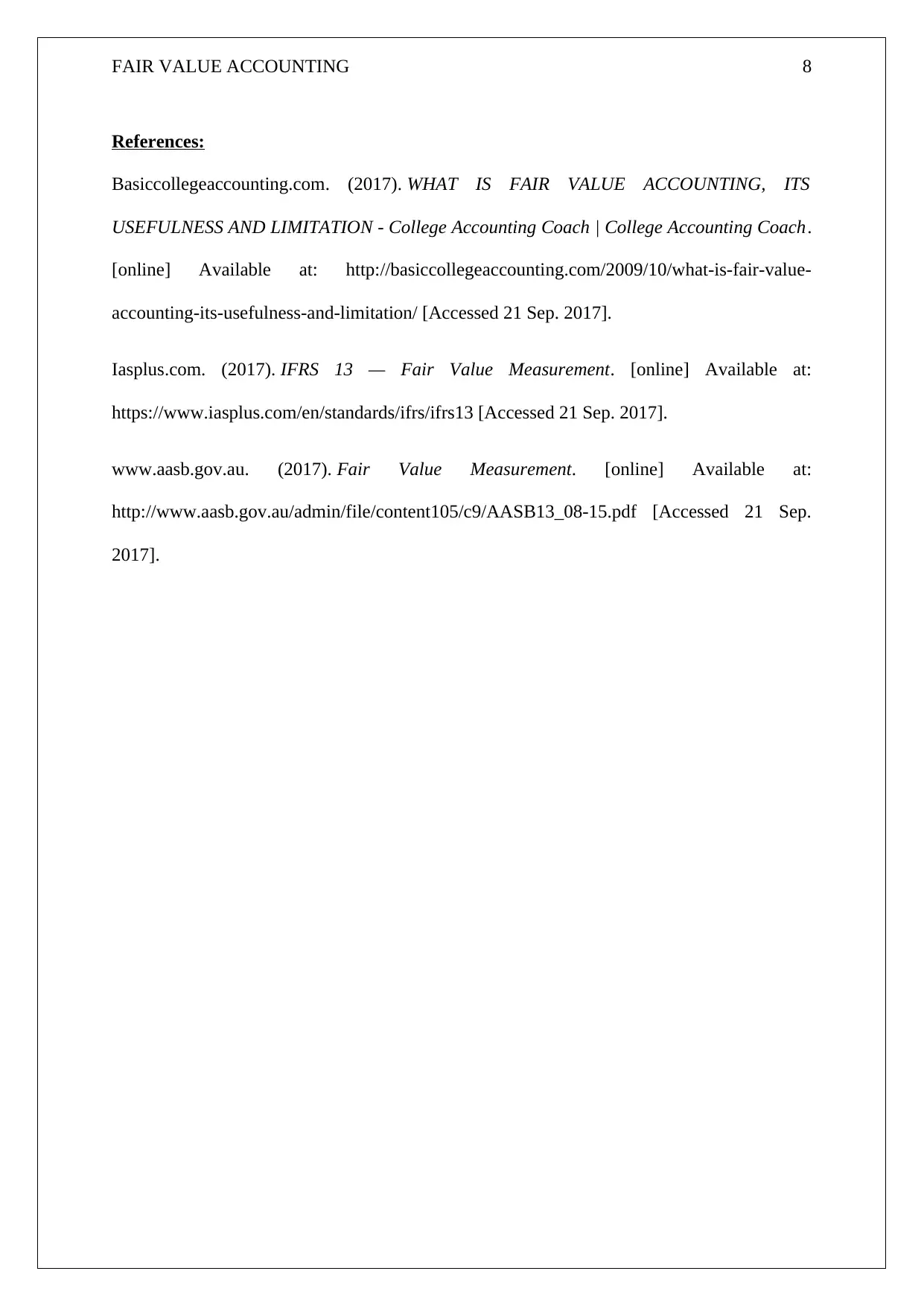
FAIR VALUE ACCOUNTING 8
References:
Basiccollegeaccounting.com. (2017). WHAT IS FAIR VALUE ACCOUNTING, ITS
USEFULNESS AND LIMITATION - College Accounting Coach | College Accounting Coach.
[online] Available at: http://basiccollegeaccounting.com/2009/10/what-is-fair-value-
accounting-its-usefulness-and-limitation/ [Accessed 21 Sep. 2017].
Iasplus.com. (2017). IFRS 13 — Fair Value Measurement. [online] Available at:
https://www.iasplus.com/en/standards/ifrs/ifrs13 [Accessed 21 Sep. 2017].
www.aasb.gov.au. (2017). Fair Value Measurement. [online] Available at:
http://www.aasb.gov.au/admin/file/content105/c9/AASB13_08-15.pdf [Accessed 21 Sep.
2017].
References:
Basiccollegeaccounting.com. (2017). WHAT IS FAIR VALUE ACCOUNTING, ITS
USEFULNESS AND LIMITATION - College Accounting Coach | College Accounting Coach.
[online] Available at: http://basiccollegeaccounting.com/2009/10/what-is-fair-value-
accounting-its-usefulness-and-limitation/ [Accessed 21 Sep. 2017].
Iasplus.com. (2017). IFRS 13 — Fair Value Measurement. [online] Available at:
https://www.iasplus.com/en/standards/ifrs/ifrs13 [Accessed 21 Sep. 2017].
www.aasb.gov.au. (2017). Fair Value Measurement. [online] Available at:
http://www.aasb.gov.au/admin/file/content105/c9/AASB13_08-15.pdf [Accessed 21 Sep.
2017].
1 out of 8
Related Documents
Your All-in-One AI-Powered Toolkit for Academic Success.
+13062052269
info@desklib.com
Available 24*7 on WhatsApp / Email
![[object Object]](/_next/static/media/star-bottom.7253800d.svg)
Unlock your academic potential
Copyright © 2020–2025 A2Z Services. All Rights Reserved. Developed and managed by ZUCOL.





